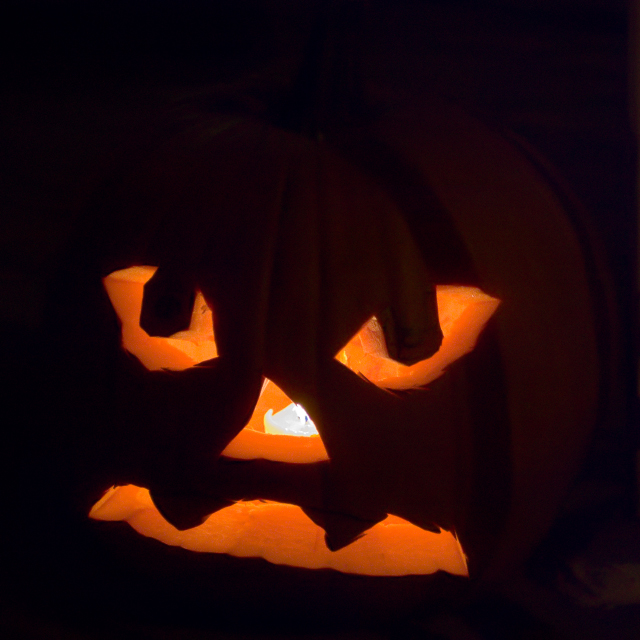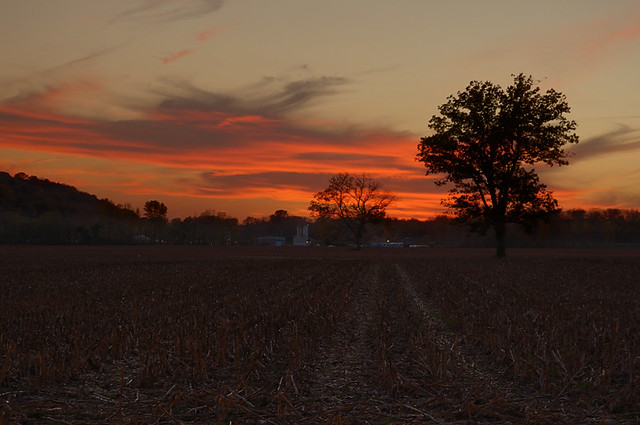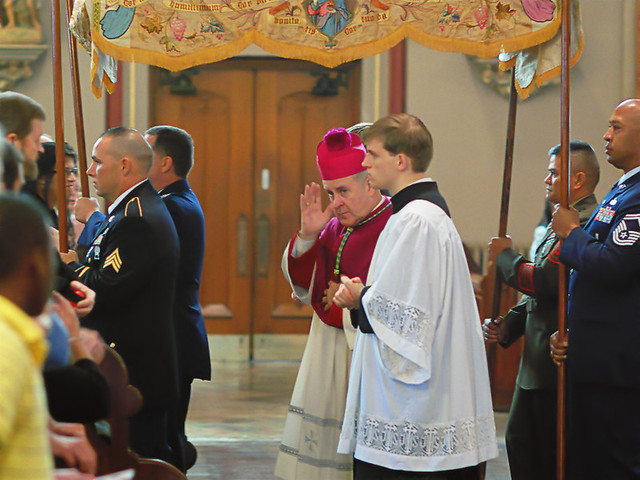|
Monday, October 31, 2011
Placare Christe servulis
A HYMN, for Vespers of the Eve of All Saints Day:
— Pope Urban VIII
Saturday, October 29, 2011
Autumn in the Ozarks
Oratory Prints Available
SUPPORTING THE APOSTOLATE of Saint Francis de Sales Oratory and the Institute of Christ the King Sovereign Priest, a limited edition of photographic art prints are now offered for sale by the Oratory:
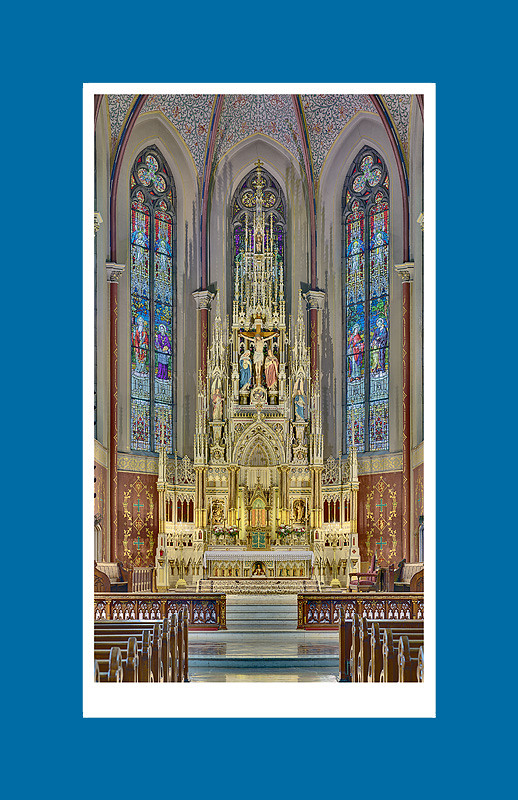
These will be sold for $100 each at the Seminary breakfast on Sunday:
SUPPORT THE INSTITUTE’S SEMINARY IN GRICIGLIANO: BREAKFAST
ON THE FEAST OFCHRIST THE KINGCANON WIENER AND THE SEMINARY SOCIETY SAINT LOUIS CORDIALLY INVITE YOU TO JOIN THEM FOR BREAKFAST ON THE FEAST OF CHRIST THE KING.
This will be an opportunity to learn more about the Seminary, meet the newest candidates, and to offer our prayerful support for
our future priests, while enjoying a bountiful breakfast at veryreasonable prices.MENU:
Scrambled Eggs, Sausage, Bacon, Biscuits & GravyPancakes, Sweet RollsCoffee, Tea, Milk & Juice
PRICE:Ages 2 and under: FREEAges 11 and under: $4.00Ages 12 and up: $7.00Large family maximum: $30.00PLUS:Talk by Canon WienerVideo Presentation by Canon Huberfeld Personal Messages from Gricigliano 50/50 RaffleRector’s RaffleAttendance Prizes for the Children Sign-up to Pray for Individual Seminarians BREAKFAST WILL BE SERVED AFTER BOTH THE 8:00 & 10:00 a.m. MASSES
All proceeds will be used for the benefit of the Seminary in Gricigliano, Italy.
- EVERYONE IS WELCOME -RSVP WOULD BE HELPFUL TO ESTIMATE ATTENDANCE: maryhayworthss@gmail.com
These prints are a ¼ size reproduction of a major new photographic work I did for the Oratory this past summer. These high quality giclée prints were made under my direction at Diversified Lab of Brentwood, Missouri. The image size is 12-½ x 7 inches on an 11x17 inch matte. The photo is attached with removable art adhesive if you desire to change the matting. This is a limited edition of 50 prints; each one is signed and numbered. You can purchase a copy of this print at the Seminary breakfast on Sunday, or you can order a copy by calling the Oratory rectory at (314) 771-3100.
Although I had long dabbled in photography, the end results of my art were usually unsatisfactory. It was not until I had become Catholic and wanted to produce worthy photographs of the Church's temples of God that my photographic work improved: “Behold, I make all things new.” Inspired by the Church’s great patrimony of art, and by the art theories discovered by her philosophers and theologians, I started re-learning photography from scratch.
When I was asked to photograph something for the Oratory, I never had any subject in mind other than the remarkable high altar reredos, which is 52 feet high. It is polychromed carved wood and was made by the E. Hackner Company of La Crosse, Wisconsin. No other subject within the Oratory has such an epic scale, being able to be captured in a single image. We can rightly say “Awesome is this place; this is the house of God and gate of Heaven."
When I photograph architecture, I try to reflect the symmetry and proportions inherent in the architectural element, as well as faithfully render the color. Although these subjects are three dimensional, I attempt to eliminate perspective as much as possible, to give the viewer a sense of the object in itself rather than simply a particular point of view. To this end, I attempt to eliminate any tilt or off centered compositions, keeping vertical lines vertical and horizontal lines horizontal. I also attempt to flatten the image as much as possible, like an architect’s orthographic projection drawing. Clearly, this is not completely possible with basic photographic technology, but I can come fairly close.
To capture this kind of composition, I attempt to get as far away from my subject as practical, and align my camera if possible with the principal axes of the subject to eliminate converging lines of perspective. The use of a telephoto lens helps flatten the subject. Overall sharpness and focus put our attention on the subject itself rather on the artifice of the camera. The lines of perspective on the rows of pews on the bottom, and the fact that the pews are obviously out of focus, shatter the illusion of a flat representation and remind the viewer that this is indeed a photograph.
To bring out the color of the reredos, I adjusted the camera and did post processing to account for the color and quality of the light; the best color correction is found in the altar area near the bottom. Were I to do this again, I’d attempt to correct more strongly for the relatively blue color of the light coming through the windows; however, I think the range of colors in this print are pleasing. As the altar is illumined with artificial lighting of good spectral quality, supplemented with the natural daylight coming through the windows, I think the color rendering here is attractive without harsh the magenta and green tones often found with newer gas discharge lighting.
My intent was to capture more detail in this image than is visible to even the sharpest human eye; to bring out detail, either artistically intended or damage due to age and wear. Perfection is not shown here, for only God is perfect. We can see both finely carved details as well as fine cracks and water damage. You can support the preservation of the Oratory here: http://www.traditionfortomorrow.com.
My model of digital camera is famed for producing quality, low-noise images, but the resolution of this somewhat antiquated sensor and my lenses aren’t designed to produce large-scale images. Adequate cameras tend to cost as much as luxury automobiles, are used in high-end fashion magazines, and so are quite out of my means — and such cameras lack flexibility and practicality also. As an inexpensive yet time-consuming alternative, this image is a composite made up of numerous individual tiles. This required me to take very many photographs from one spot — 288 photographs in total. Using an 85 mm f/1.4 lens — known for producing sharp images with insignificant optical distortion — I took multiple exposures of small sections of the reredos over a period of nearly two hours. The lens was set at its sharpest setting, f/5.6, and the focus point was halfway in distance between the top of the apse and the communion railing.
I took these photos during a brutally hot day in July, and the high temperature in the building risked increasing the digital noise coming from my sensor. To counteract this, for each image I took a counter-image with the same exposure but with the shutter closed; the camera electronics subtracted out the ‘dark frame’ from the exposed frame to reduce this added noise. This is a technique originally devised by astronomers to get clean star images. The final image is exceptionally clean with little visible digital noise.
This was followed by at least 40 hours of work on the computer, fusing the various separate images together to produce a single image. While many commercial software packages can fuse together images in this way, they all trade off speed and simplicity for final image quality. Rather, I used computer-science grade software that allows for far greater control over the blending process, correcting for even slight shifts of the camera or lighting, and correcting lens defects. For the final image, I rendered the multiple images into a single rectilinear photo, using a mathematical projection which keeps the lines of the subject straight.
A single exposure has only a limited dynamic range of tones of brightness and darkness it can capture. The ratio of illumination from the brightest light coming through the window to the darkest visible shadow was at least 10,000:1, which exceeds the range of the camera and is also far greater than the range of tones available in print, which is about 100:1. Anything out of this range is either pure black or pure white. This is unacceptable; I intended to capture as many of the tones in the scene as possible. Many of the 288 photos I took that day were multiple exposures, adjusting the shutter speed time to alternatively capture the shadows, mid tones, highlights, and windows. The software on the computer selects the best exposed tones from each image and seamlessly blends it in with the others producing an image that has full range of tones. Over the years, I’ve experimented with various methods of exposure blending, but I created my own techniques which preserve the colors of highlights and shadows very well. Very little tonality in this scene was lost: there is a small patch on one of the windows which is pure white, and some shadows near the crucifix are pure black, however, the dynamic range seen here nearly matches that of the human eye, and there is some shadow detail which actually exceeds what can be seen casually. This would not be possible with only a single activation of the shutter.
Naively compressing the tones of the image to print would produce an image without much texture, and so I enhanced local contrast with techniques I’ve devised to produce visually enhanced texture without obvious digital artifacts. This is similar to the technique used by artists when producing polychrome statues: colors within folds of cloth are either tinted or shaded to enhance the visual impression of light and dark. An inevitable side effect of this tonal compression is that the final image may resemble a painting more than a photograph. I don’t think this is a bad thing: actually, I find myself being more inspired by painting — a superior art form — as I learn more about photography.
Copies of the print may be purchased at the Oratory.

Location:
Saint Francis de Sales Oratory
Thursday, October 27, 2011
In the Beginning…
…GOD CREATED Heaven and Earth... (Genesis 1:1)
So begins Sacred Scripture. According to the familiar structure of the Creation account, God creates the firmament, dry land, the seas, and so forth:
And God said: Be light made. And light was made. And God saw the light, that it was…What?
Recently I gave a talk, and quoted a similar line from Genesis. The people in the audience immediately answered back ‘good’. Well, that is what nearly all English language Bible translations say (one says ‘pleasing’). Good is a good word, evocative of goodness, but it might not be the best translation, not capturing its full or highest meaning; would you rather be told that you did a good job or an excellent job? Perhaps a better or more evocative or powerful translation might be And God saw the light, that it was beautiful, or perhaps that it was good and beautiful.
Here is the Hebrew text: וַיַּרְא אֱלֹהִים אֶת-הָאוֹר, כִּי-טוֹב; And also consider the ancient translations of the Greek Septuagint and Saint Jerome’s Vulgate Latin, which were made close to the original source and culture:
καὶ εἶδεν ὁ θεὸς τὸ φῶς ὅτι καλόνThe Hebrew word for ‘good’— highlighted above in red — is טוֹב or ’tov’; the Greek equivalent is καλόν, ‘kalon’ and the Latin translation is bona.
Et vidit Deus lucem quod esset bona
The Hebrew adjective tov is undoubtably well known in the phrase ‘mazel tov’, usually translated as ‘good luck’ but literally is something more like the Latin rorate coeli; a thanksgiving for divine grace, which is likened to dew dropped down from Heaven. While tov is usually translated as ‘good’, it can also mean kind, thoughtful, moral, pleasing, appropriate, fitting, or successful.
Likewise, καλόν means beautiful, fair, shapely, beloved, of fine quality, auspicious, moral, noble, honorable, excellent, virtuous, or favorable; while bona means moral, honest, of good standing, excellent, comfortable, fine, honorable, artistically valuable, favorable, prosperous, lucky, fortunate, kind, noble, auspicious, or beautiful. All three words here are far broader and nobler than the typically tepid use the of English word ‘good'.
Tov is also one of many Hebrew words for ‘beautiful’, and this meaning, along with goodness, is said to be closer to what is intended in Genesis. From what I’ve read, of all the words for beautiful, tov means the most inner and modest, or hidden kind of beauty, like the beauty of wisdom that can be found in the face of an elderly person, or the beauty of soul of a saint. This word also includes the notion of pregnancy; consider that a fetus is a goodness hiding unseen inside the womb. This beauty has unitive and procreative aspects: a man is drawn to a woman’s beauty, while a woman receives a man if he is good, which leads to pregnancy. By analogy, goodness and beauty draws Man and God together, and Creation is pregnant with God’s truth, goodness, and beauty, even if we can’t always see it.
In Judaism, the hidden beauty of Creation can be found in the Torah with God’s law. But for Catholics, we can also find this kind of beauty foreshadowing the Incarnation, the Blessed Virgin, the Church, the Eucharist, and the world to come. The beauty of nature can also inspire Catholic artists, following the example of the Jewish Temple, which was richly decorated with representations of Creation. In accordance with long artistic tradition, artists also can intuit the hidden, beautiful symbolism found in nature.
That Creation is good, fitting, noble, valuable, auspicious, and beautiful means that artists can imitate or represent nature in ways that are also good and beautiful, despite our world being fallen, and that this beauty and goodness can draw us closer to God.
Tuesday, October 25, 2011
Monstrance for Sale
A MONSTRANCE, associated with Blessed Francis Xavier Seelos, will go on sale at Sotheby’s in New York on November 16th.
See the article Monstrance from St. Alphonsus Church going up for auction.
Generally speaking, sacred objects ought not be sold, but the owner is in dire financial need. Perhaps Bl. Seelos would favor us with a miracle?
Monday, October 17, 2011
Sunset

Location:
Chesterfield Valley, Missouri
Sunday, October 16, 2011
Photos of Holy Cross Church, in Cuba, Missouri
HERE ARE PHOTOS of Holy Cross Church, in Cuba, Missouri. The church is located in Crawford County, about 84 highway miles southwest of downtown Saint Louis. It is a part of the Diocese of Jefferson City.
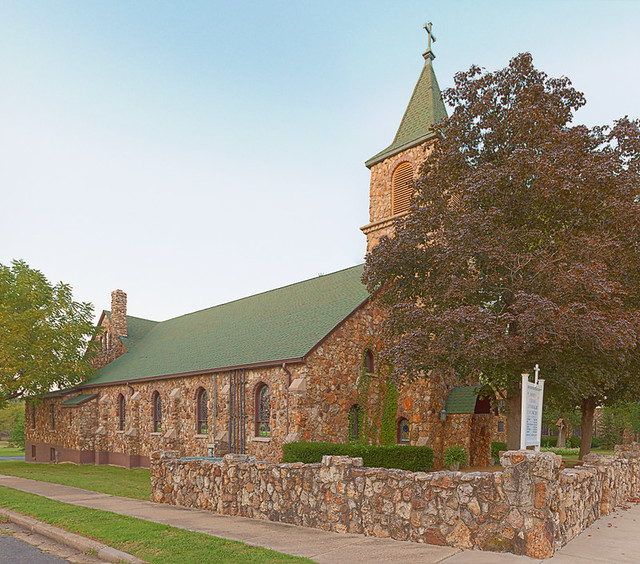
This parish was founded in 1880, and this church building dates from 1936.
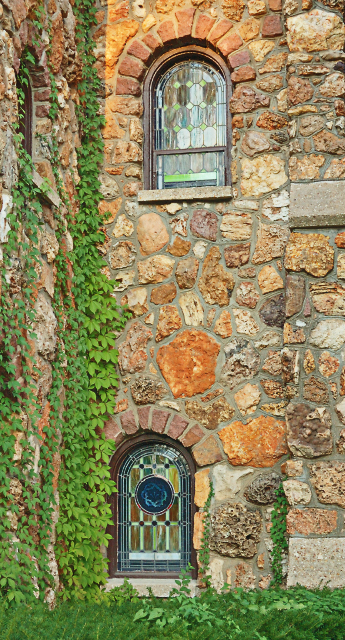
The walls of the church are made with decorative stone from the Ozark region. Although my geological knowledge is rather rusty, it appears as though the stone used includes native red granite, a severely weathered limestone called ‘sponge rock’, the barium ore tiff, flint, and some others. The masonry was done by Albert C. Stumpf, who also worked for the New Deal WPA program. This kind of vernacular architecture was highly valued in the 1930s — a culmination of nationalistic and folk-art trends — but it disappeared by the 1940s because of World War II and the subsequent International Modernist spirit of the post-war era.
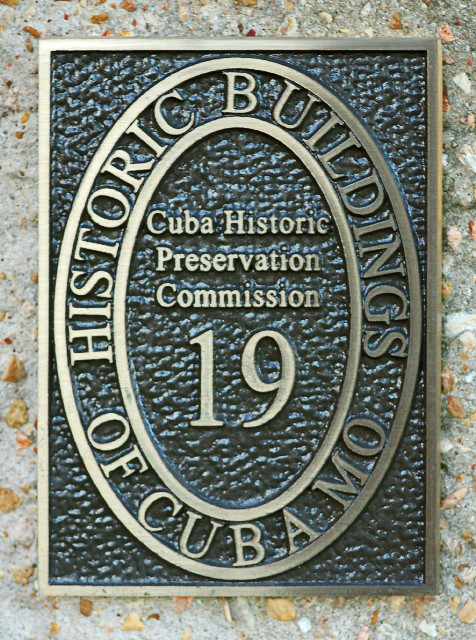
The town of Cuba is charming, and caters to tourists traveling along Interstate 44 and the famed Route 66. According to a history of the town:
Cuba was founded in 1857 in anticipation of the construction of the southern branch of the Pacific Railroad. In the period before the railroad, early settlers brought with them a pioneering spirit seeking whatever livelihood was available to support their families. Many found work in the iron ore mining industry, with oxen carts providing the transportation of agricultural and mining products to St. Louis. Mining would remain an important industry for nearly 50 years.
The origin of the name “Cuba” remains a matter of legend. It may have been chosen as a symbol of sympathy for the people of the island of Cuba in their struggle for independence from Spain. Another version tells that two former 49er gold miners had visited the isle of Cuba and found it beautiful. Another story says that George M. Jamison, who had established the area’s first post office Amanda, named after his wife, again wanted to name the new town Amanda but others objected. A stick was thrown in the air, and the direction the pointed end landed, towards Cuba or Amanda, would name the town. One thing is certain, 150 years later its name continues to be a source of curiosity.
With the arrival of the southern branch of the Pacific Railroad in 1859-1860, the train brought a new way to get goods and send products to market. Cuba became a shipping center for agriculture and industry. From 1865-1912, Cuba was known as “The Land of the Big Red Apple.” By 1900, Cuba was the largest producer and distributor of apples in Missouri.
With the advent of the Model T, road improvements became necessary. Paving for Route 66, the “Mother Road,” through Cuba was completed in 1931. With more automobile traffic, new business opportunities were created. Restaurants, gasoline stations and motels opened their doors all along Route 66 to answer the needs of traveling motorists...
In the 1990s, many businesses in the Historic Uptown were badly in need of a facelift. In 2001, the area received a boost when Viva Cuba, a beautification organization, began an outdoor mural project along old Route 66. Drab walls were transformed into public art….

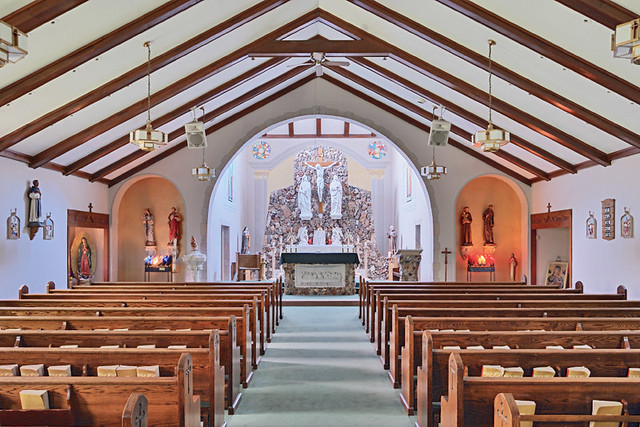
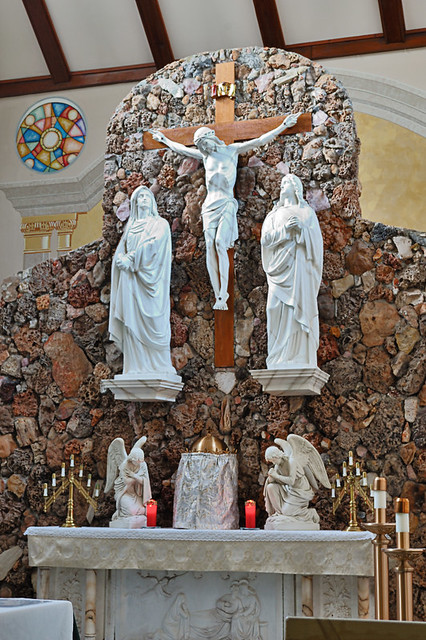
Tabernacle and crucifix.
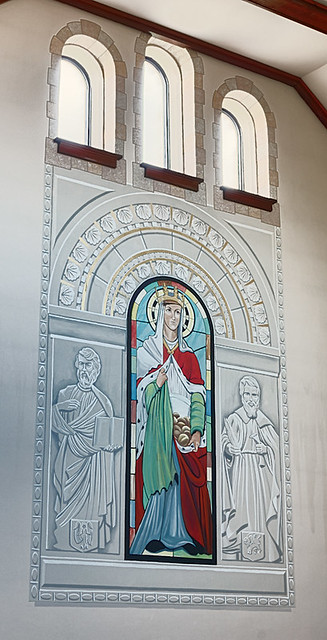
Two Evangelists flank perhaps Saint Elizabeth of Thuringia?
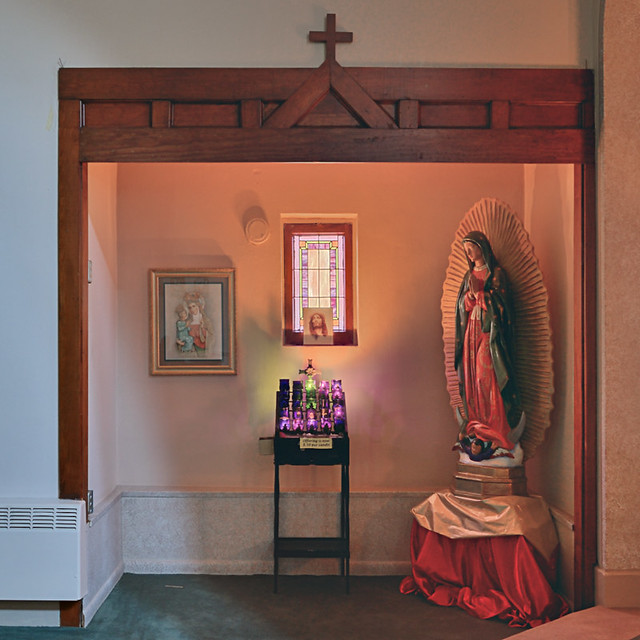
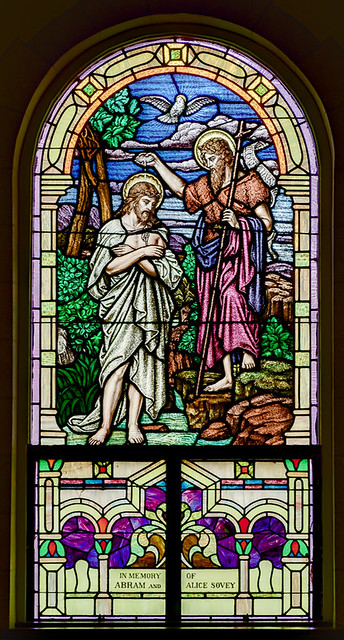
Baptism of Our Lord.
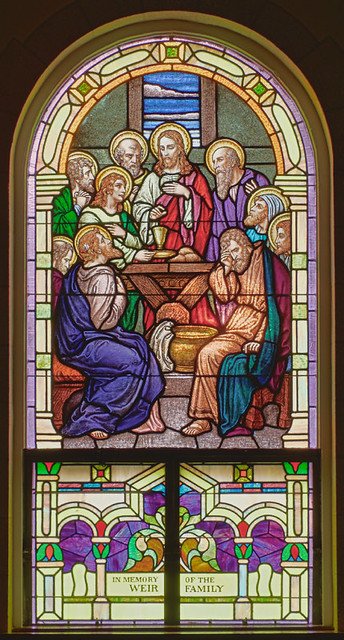
The Last Supper.
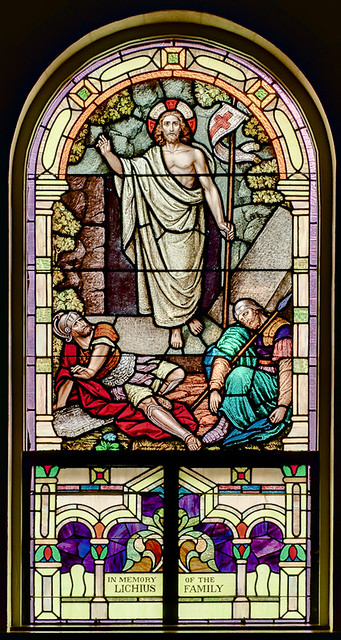
The Resurrection.
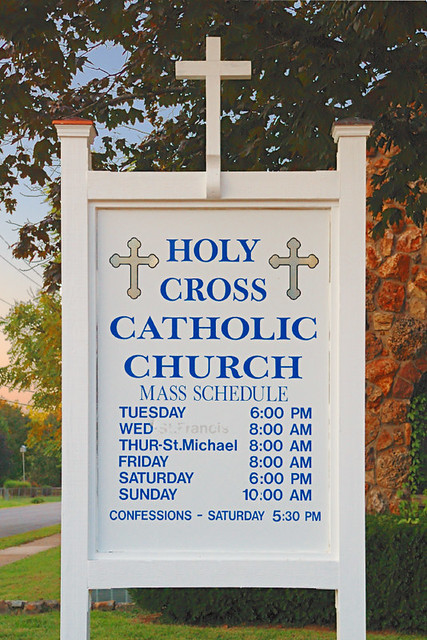
Address:
415 School Avenue
Cuba, Missouri 65453
Wednesday, October 12, 2011
Photo of Archbishop Carlson

Location:
Saint Francis de Sales Oratory
Monday, October 10, 2011
Photos of the Little Sisters of the Poor, Saint Louis Residence
HERE ARE PHOTOS of the Saint Louis Residence of the Little Sisters of the Poor, located in the Saint Louis Place neighborhood in the northern part of the City. I happened upon this place by accident, being on assignment to take photos nearby.
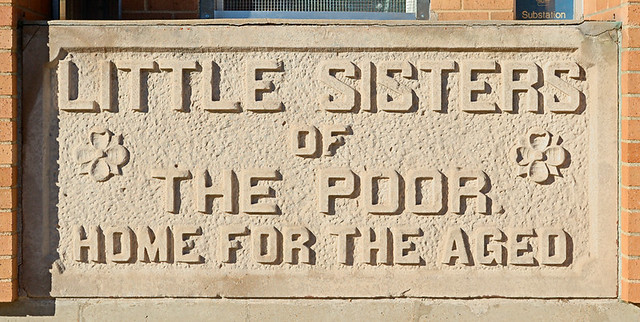
The Little Sisters of the Poor have been helping the elderly in Saint Louis since 1869. They provide help to the elderly poor without regard to religion or ethnicity, in accord with the immemorial doctrine of the Church of loving one's neighbor.
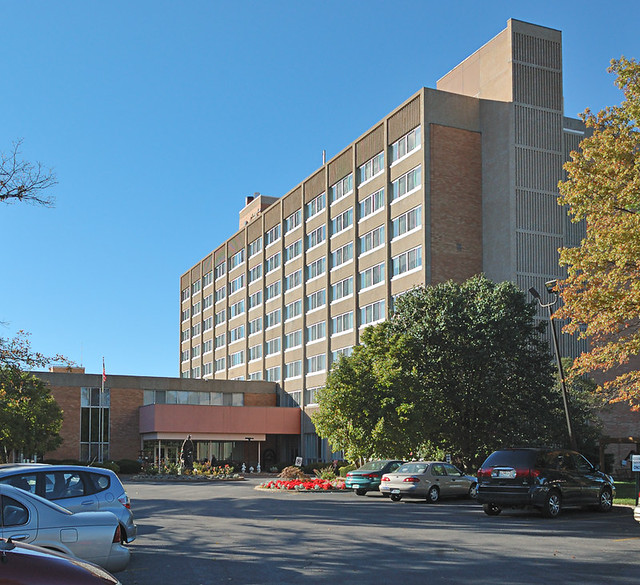
This residence dates from 1971, and according to its website, has a full-time chaplain who offers daily Mass and Rosary.
In addition to the religious vows of chastity, poverty, and obedience, the Sisters also take a fourth vow of hospitality. The Liturgy of the Hours is prayed in community three times a day, along with the Holy Mass.
The Sisters are found in 32 countries, and have 34 communities in the United States.

Saint Jeanne Jugan was beatified on October 3, 1982 by Pope John Paul II, and was canonized October 11, 2009 by Pope Benedict XVI. Her feast day is August 30th.Blessed Jeanne Jugan
Foundress of
the Little Sisters of the Poor
1792-1879
Saint Jeanne Jugan was born in 1792 in Brittany. From the Sister's website:
Jeanne Jugan grew up in a small town in revolutionary France. Times were tough. Violence ruled the day. For thousands, begging was a way of life.Here is an anecdote on the spirit of the Saint:
Those who openly practiced their faith were not merely ridiculed—they were imprisoned or killed. Jeanne received her faith formation—secretly and at great risk—from her mother and a group of women who belonged to an ecclesial movement of the day.
By the time Jeanne was four years old her father had been lost at sea. Her mother found odd jobs to make ends meet. Neighbor helped neighbor. As a young girl Jeanne worked as a shepherdess. She learned to knit and spin wool. Later she went to work as a kitchen maid for a wealthy family...
Jeanne barely learned to read and write. Her education consisted mostly of on-the-job training in the school of real life. Neither beautiful nor talented in the usual sense, she was gifted with an extraordinary heart. Jeanne was on fire with love for God!
Those who let themselves be seized by the love of Christ cannot help abandoning everything to follow him… Barely out of her teens, Jeanne felt the call of divine love. Preparing to leave home, she told her mother “God wants me for himself. He is keeping me for a work which is not yet founded.”
Jeanne took the road less traveled, setting out to work among the poor and forsaken in a local hospital...
Many years went by before Jeanne discovered her vocation. Finally, one cold winter night she met Jesus Christ in the person of an elderly, blind and infirm woman who had no one to care for her. Jeanne carried the woman home, climbed up the stairs to her small apartment and placed her in her own bed. From then on, Jeanne would sleep in the attic.
God led more poor old people to her doorstep. Generous young women came to help. Like Jeanne, they wanted to make a difference. Like her, they believed that “the poor are Our Lord.” A religious community was born!
There were so many old people in need of a home, so many souls hungry for love! The work rapidly spread across France and beyond. Struck by their spirit of humble service, local citizens dubbed the group the Little Sisters of the Poor. The name stuck!
For herself Jeanne chose the religious name Sister Mary of the Cross. She would live it in its fullness.…
The work of the Little Sisters continued to spread, borne by the wind of the Spirit. So did Jeanne’s renown—until one day she was mysteriously cast aside by an ambitious priest who had taken over the direction of the young community.
Jeanne was replaced as superior and sent out begging on behalf of the poor. And then one day she was placed in retirement, relegated to the shadows. At the time of her death 27 years later, the young Little Sisters didn’t even know that she was the foundress.
Jeanne had often told them, “We are grafted into the cross and we must carry it joyfully unto death.” How she lived these words! What a radiant example of holiness she gave to generations of Little Sisters!
Once when Jugan begged a young man for money, he hit her on the face. She replied with calmness, “You gave that to me, now give me something for the elderly.” The man was astounded by the sweetness of her reply and with all his heart he gave her all the money he had at that time.
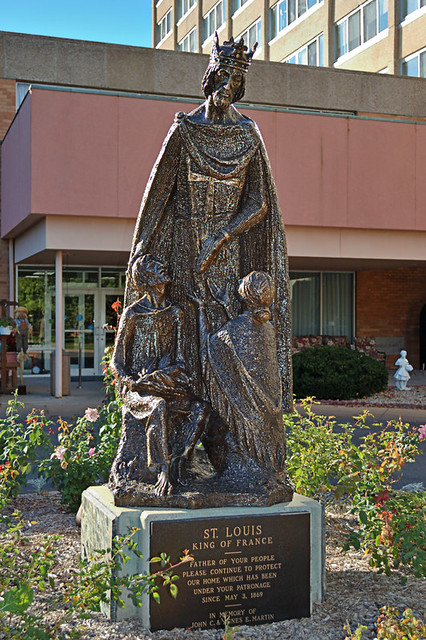
St. Louis
King of France
Father of your people
Please continue to protect
our home which has been
under your patronage
since May 3, 1869
In memory of
John C. & Agnes E. Martin
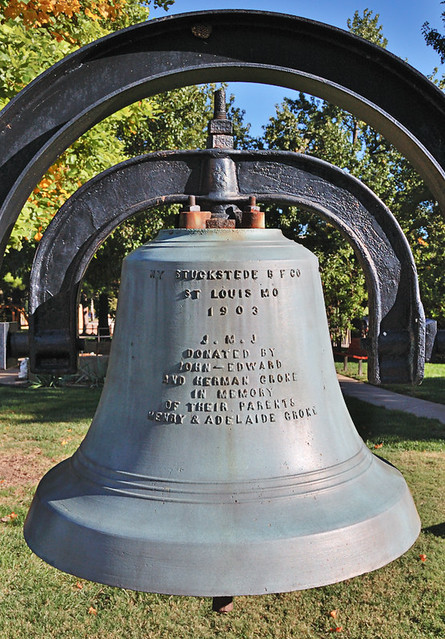
The Stuckstede family of Saint Louis operated bell foundries from 1855 to 1961, and was the largest producer of bells in the western United States; hundreds of their bells can still be found in the Saint Louis region. The Grones mentioned here owned a brewery and a soda water company.Hy Stuckstede B F Co
St. Louis MO
1903
J.M.J
Donated by
John-Edward
and Herman Grone
In memory
of their parents
Henry & Adelaide Grone
Underneath the bell a plaque reads:
The old location of the Sisters is at the corner of Grand and Gravois and is now a Schnucks market. However, the old stone wall from the property can still be seen there.In 1903
This bell was first hung
in the tower of
The Little Sisters of the Poor
3400 South Grand Avenue
It was moved to this location
May 4, 1989
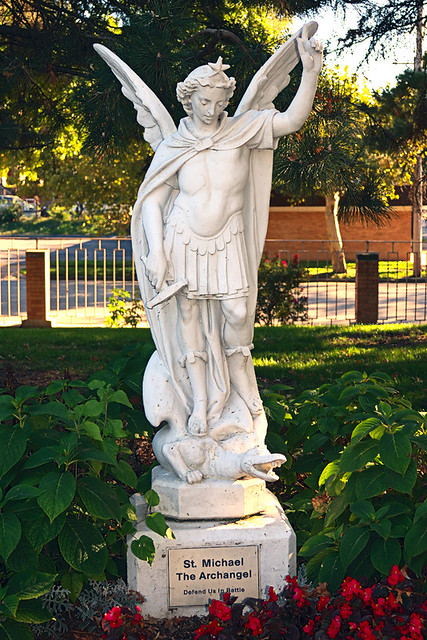
St. Michael
The Archangel
Defend Us in Battle
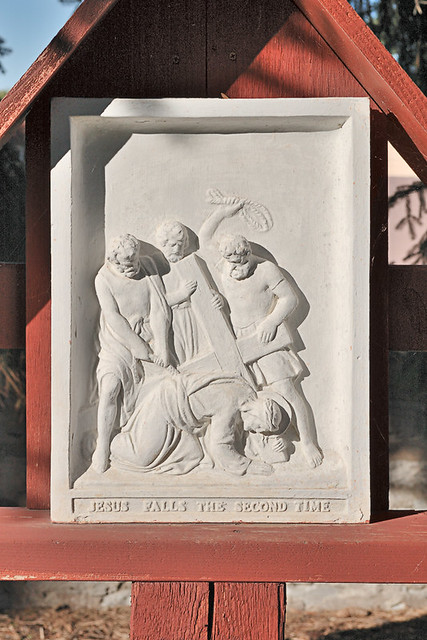
Jesus falls the second time.
Address:
3225 North Florissant Avenue
St Louis, Missouri 63107
Friday, October 07, 2011
Our Lady of the Rosary
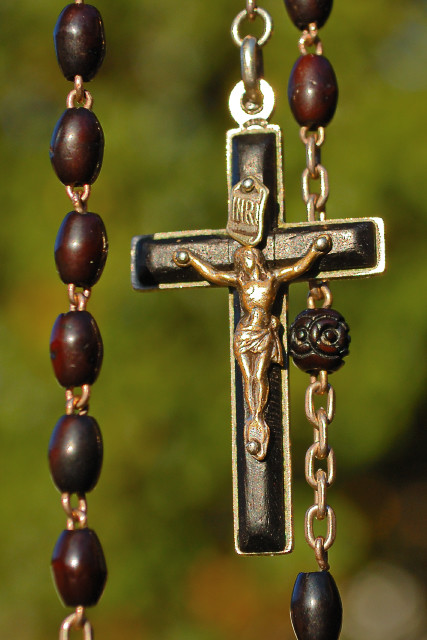
The feast of Our Lady of the Rosary, formerly known as Our Lady of Victories, commemorates the defeat of a vast Ottoman fleet at the Battle of Lepanto, and is held in honor of the Blessed Virgin. According to Wikipedia:
The Victory of the Holy League prevented the Mediterranean Sea from becoming an uncontested highway for Muslim forces, protected Italy from a major Ottoman invasion, and prevented the Ottomans from advancing further into the southern flank of Europe.
Thursday, October 06, 2011
Newsletter from the Oratory
|

Labels:
events
Location:
Saint Francis de Sales Oratory
Tuesday, October 04, 2011
Feast of Saint Francis of Assisi

Statue of Saint Francis, found next to a well, at Saint Joseph Church, in Apple Creek, Missouri. Photo taken 12/31/2010.
Saint Francis was preaching to his brethren:
“In the name of the Lord, go forth modestly, two and two, observing strict silence from the morning till after the hour of Tierce, praying to God from your hearts. Let no idle or useless words be heard among you; although you are travelling, your deportment should be as humble and as decorous as if you were in a hermitage, or in your cells. For wherever we are, and, whithersoever we may be going, we have always our vocation with us; our brother, the body, is our cell, and the soul is the hermit, who dwells in it to think of God and to pray to Him. If a religious soul does not dwell quietly in the cell of the body, the external cells will be of little use to him. Behave, then, in such manner in the world, that whosoever may see or hear you, may be moved to devotion, and praise our Heavenly Father to whom alone all glory belongs. Proclaim peace to all men, but have it in your hearts, as well as in your mouths. Give to no one cause for anger, nor for scandal; on the contrary, by your own mildness, induce every one to feel benignly, and draw them to union and to concord. We are called to heal the wounded, console the afflicted, and to bring back those who err; many may seem to you to be members of the devil, who will one day be disciples of Jesus Christ.”— The Life and Legends of Saint Francis of Assisi by Father Candide Chalippe.

Subscribe to:
Posts (Atom)

